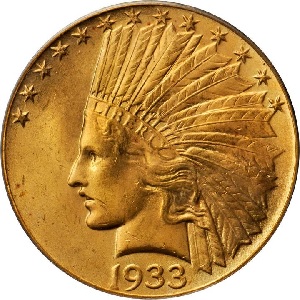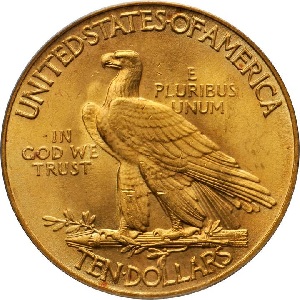1933 Indian Head $10 Eagle
Consider these two $10 eagle gold coins:
- 1797 Capped Bust with small eagle reverse
- 1933 Indian Head
Both are very rare, with just a few dozen examples of each surviving to this day.(1) However, the paths taken to reach their current status as rarities could not be more divergent.
Few 1797 eagles exist nowadays because 1) the initial mintage was very small to begin with, and 2) attrition slowly claimed most of its population over a period of decades.
On the other hand, over 300,000 pieces of the 1933 eagle were once sitting idle, waiting to be released into the fabric of America. That was before a presidential decree virtually eliminated the entire universe of the date, instantly making it a famous rarity and one of the greatest United States coins ever.(2)
Here’s the scoop on the 1933 Indian Head eagle…
In January and February of 1933, the Philadelphia Mint struck 312,500 eagles, but none were sent to the Federal Reserve for distribution due to lack of demand from the public in the struggling Great Depression economy. Instead, they remained in federal government vaults as currency reserves.(3)
On April 5, 1933, President Franklin Roosevelt signed Executive Order 6102 "forbidding the hoarding of gold coin, gold bullion, and gold certificates within the continental United States."
The ultimate goal of the Gold Recall was to increase the nation’s money supply, in a bid to jumpstart the American economy.
The Federal Reserve Act of 1913 mandated the government to maintain gold reserves no less than 40% of the Federal Reserve notes issued by the Treasury. By 1933, the Federal Reserve was approaching the point where no more notes could be printed because of the gold reserve constraint.
When the recall was announced, gold owners were required to turn all but small amounts of their gold in exchange for other forms of currency, paid out at the normal price of $20.67 per Troy ounce. Collectors were permitted to keep gold coinage of numismatic significance, however (thank goodness!!).
Once the gold had been secured, Uncle Sam pushed the price of gold bullion from $20.67 to $35.00 per Troy ounce. This increased the value of the nation’s gold reserves by almost 70% and empowered the Federal Reserve to print more notes for adding to the money supply.
The gold turned in by the public and the coins in government hands were converted into gold bars and housed at the Fort Know Bullion Repository in Kentucky.(4) No more gold coins were struck by the United States until 1984.(5)
Yes, FDR’s order zapped the 1933 Indian Head eagle too. All but a tiny number escaped a rendezvous with the melting pot. Those examples that got away did so legally. Unlike the 1933 $20 double eagles, private ownership of the $10 eagle from the same year has never been challenged in court.(6)
Fascinating Fact: On March 1, 1933, a total of five 1933 eagles were paid out at a Philadelphia Mint cashier’s window. These are the only examples of this date released to the public through official channels. Several dozen others were obtained legally by government employees and comprise the bulk of the survivorship we know of today.(7)
Interesting how a coin that should have been abundantly available for collectors is now regarded as one of the most fantastic rarities of the 20th century.
| Estimated survivors in all grades: 40 ?
The survivor estimate from PCGS represents an average of one or more experts' opinions as to how many examples survive of a particular coin in all grades. Survival estimates include coins that are raw, certified by PCGS, and certified by other grading services. Learn more at PCGS. |
| PCGS Rarity Scale: 8.7 ?
The 'PCGS CoinFacts Rarity Scale' assesses the relative rarity of all U.S. coins, based on estimated surviving examples. The scale runs from 1.0 to 10.0. The higher the number, the rarer the coin.
Learn more at PCGS. |
| Click HERE to check for availability on eBay** |
Preview of eBay selection (expect to see zilch for this rarity, but also try the HERE link above):
 |
 |
| Trendline Avg = 5.55 | CLASSIC RARITY |
Historic Value Trend Charts:
| Last updated 9-6-24 | Return to Key Date Coin List | |
| Compare to Common Date Coin of Same Type | ||
|
|
||
| Download Charts to Your Computer | ||
Sources
1. PCGS Coinfacts.
2. Garrett, Jeff and Guth, Ron. 100 Greatest U.S. Coins, 5th ed. Pelham, AL: Whitman Publishing, 2019.
3. Heritage Auctions. 1933 $10. Jan 2020 Auction.
4. Heritage Auctions. 1933 $10. Jan 2020 Auction.
5. Yeoman, R.S. and Garrett, Jeff, et al. A Guide Book of United States Coins, 75th ed. Pelham, AL: Whitman Publishing, 2021.
6. Heritage Auctions. 1933 $10. Apr 2015 Auction.
7. Heritage Auctions. 1933 $10. Jan 2020 Auction.
**Many very fine coin dealers sell on eBay. At any point in time, there may be over one million search results for United States coins. This includes quite a few of the recommendations on our Key Date Coin List.
If you’re thinking about purchasing a rare coin, eBay is certainly worth a look. For your convenience, the links from this site to eBay are coded to bring up only coins certified by PCGS and NGC.
As is always, always the case, never buy a valuable coin from a seller whose trustworthiness cannot be verified. Learn more about this at our chapter Best Places to Buy Coins, which also has a section on doing business on eBay.
In the interest of full disclosure, Rare Coins 101 receives a small commission anytime someone connects to eBay from this site and purchases something.
Coin images by Stack's Bowers Galleries.


